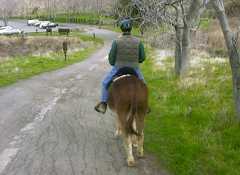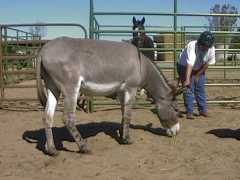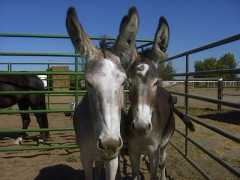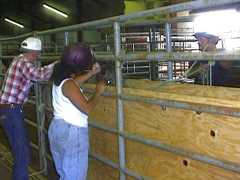"Gentling Wild Donkeys-
|
Checking out the "equipment"
|
| THE QUIET HOUR |
OBJECTIVE: Engage the Donkey's CuriosityThe fastest way to socialize a donkey to the human environment is to activate his curiosity. One of the best ways to make a donkey curious is to ignore him and encourage him to investigate us. There are several ways we can do this, but in general we want to be very quiet and peaceful around the donkey for the first hour or so, letting the donkey make the first advances on his terms. One useful activity is to enter the donkey's pen frequently during the day to quietly tinker about or do "odd jobs." The idea here is not to focus our attention on the donkey, but be present, move around non-threateningly and let the donkey get used to our appearance, smell and movements. At first the donkey may move to a far corner with anxiety, but before too long the donkey should be showing signs of curiosity. When the donkey displays more curiosity than fear, we may drop a small handful of hay just before we leave or sit quietly in a chair inside the pen with a patch of hay close by or under the chair. |
Doing "odd jobs"
|
|
| |
|
OBJECTIVE: Make First ContactSome donkeys will come up and make contact once they no longer regard us as a threat. Others are more standoffish, prefering to interact from a short distance away. We cover this distance without chasing the donkey by using a bamboo pole. The idea when using the pole is not to torment the donkey, but to make gentle contact and start a scratching motion that feels to the donkey like his buddy is grooming him. This action is both confusing and feels good to the donkey. If we scratch and stroke the donkey with the intent of making him feel good, he's not going to get too worried about our getting steadily closer and making contact with our hands. |
First contact with the pole
|
Working up the pole
|
Now scratching using hands
|
| A squeeze chute can also be used. The donkey should be allowed to first explore the chute, perhaps baited by a bit of hay. After the donkey is comfortable in the chute, he can start to be handled. Any approach toward a confined animal should be quiet. A panicked animal will not learn efficiently. If necessary, we start by rubbing the donkey with a crop or pole until he is comfortable with our approach. If we don't make being in the chute a traumatic experience, he won't fear going back into it later. |
John Sharp using a squeeze
|
|
| |
|
Continue to Part ThreeReturn to Part OnePress "Back" to return to the page which brought you hereReturn to KBR Training SectionReturn to KBR World of Wild Horses & BurrosReturn to LRTC Wild Horse MentorsGo To
| |





